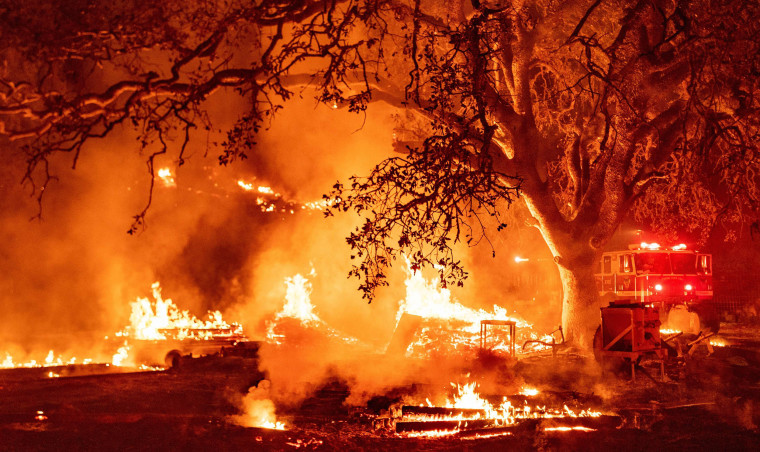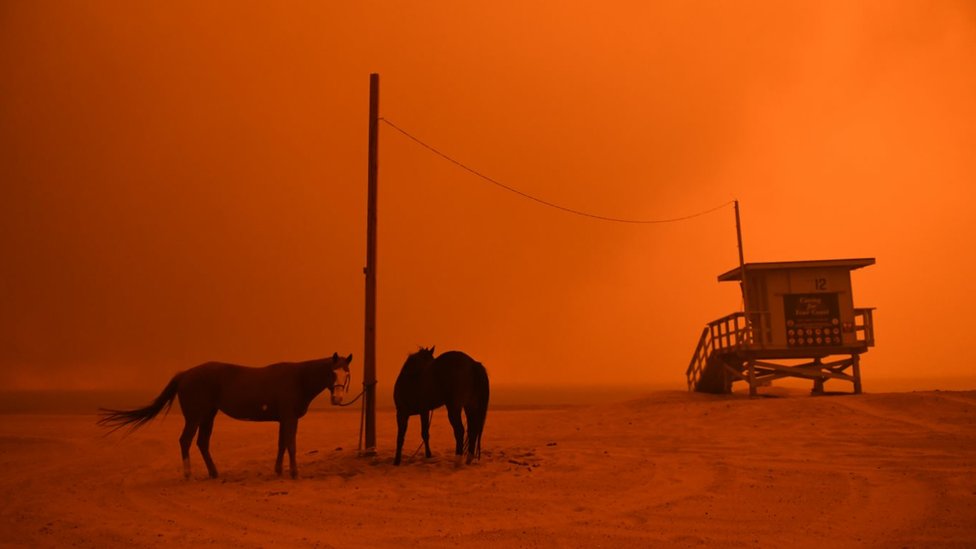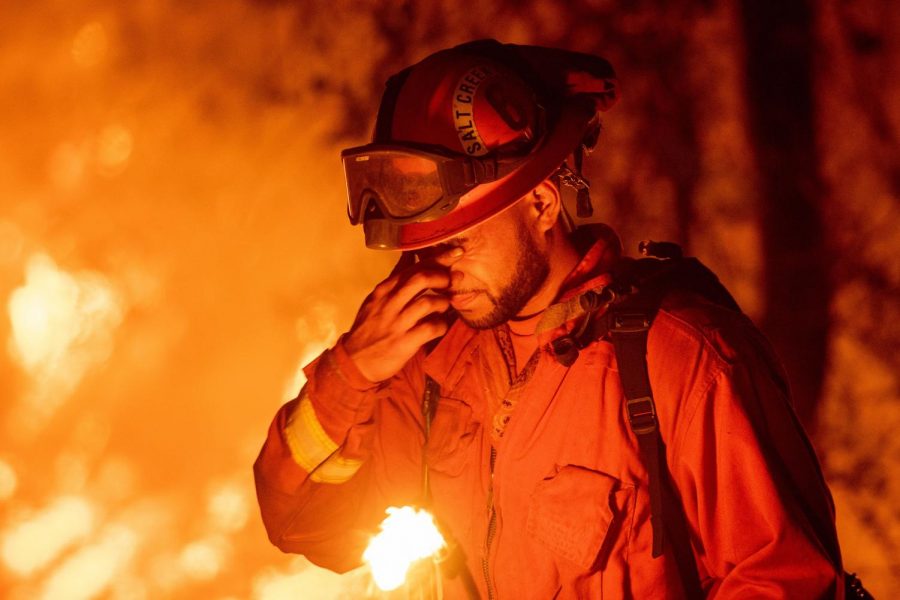California in flames
Climate change, global warming, and hot temperatures spell trouble for the western states
October 7, 2020
Wildfires have wreaked havoc across the west coast, sparking fire after fire throughout states such as California and Oregon.

Remember back in the day* (*last year) when most of Australia was on fire? Or even when the Amazon rainforest was on fire, along with Indonesia and Siberia? Just like the fires on the west coast, these were wildfires sparked by the dry, hot conditions in these areas (or in the Amazon rainforest’s case, deforestation also played a big role). In all cases, these fires took months to put out, but not in time to save many homes, lives, and other important parts of the world’s ecosystems that were destroyed in between the beginning and end of these events.
Every year, California (and parts of the neighboring states) is ravaged by wildfires that ruin ecosystems and the local wildlife. It might just be me, but it seems like these fires have been pretty consistent since 2015 or so; at this point they’re kind of normal. Are they less common than we think? How much of the wildfires are caused by global warming? Is there anything that can be done to prevent these fires? What can WE do?
Climate Change
Global warming and wildfires are a vicious cycle of burn > burnt > burn > burnt. This is because after burning once, the wildlife in the areas that have been affected by these wildfires are more susceptible to being burnt again later, according to a study done by Colorado State University. The areas do not have enough time to regenerate between fires, and therefore they cannot withstand. Interestingly enough, this was found to be true about moist areas AND dry areas that have been affected by wildfires in the past 21 years– it’s all based around the warmth of the climate.

It’s no secret that the climate has been changing over time during our lives (remember when there was actual snow during the winter? Good times!). The Earth goes through natural periods of cold and warmth– that’s how we got the Ice Age. However, it is scientifically proven that things have gotten exponentially warmer since the mid-20th century, according to the NASA. The Earth’s surface temp has risen 1.62 degrees Fahrenheit since the late nineteenth century which has been caused by increased amounts of carbon dioxide and other human-made emissions into the atmosphere. This has led to lower ocean levels, less snow cover, the melting of the glaciers, and, yes, the California wildfires. How so?
When it’s extremely hot outside (as it is on the west coast), there is less moisture in the air and then moisture is drawn out from the land, according to the organization Carbon Brief.
This makes easy kindling for fires to start. Especially when you, say, have a gender reveal party in the year 2020 (of all years!) that includes an actual explosive device that causes a fire in a dense, dry area of Los Angeles and causes millions of dollars worth of damage. Yes, that happened. They tried to put the fire out with water bottles, according to CNN (In case you were wondering, though, it was revealed the baby is a boy!). So this year, the fires were not only caused by global warming, but also general ignorance. I mean, why would anyone think, in the middle of summer in an area prone to wildfires, that that was a good idea? So the most Instagram-worthy day of you and your unborn son’s lives was a real bust. Instead of maybe getting a couple hundred likes on the ‘Gram, you caused (I cannot stress this enough) millions of dollars of damage to the west coast. We’ve all been there.
It was previously said that a lot of the issues at hand here are caused by global warming and the carbon footprints left behind that are deeply harming the environment, wildlife within that environment, and ourselves. However, it must be said that most of the carbon emissions and greenhouse gases in the atmosphere are not fully our faults as normal civilians (though we do contribute; don’t get it twisted).
Roughly 71% of carbon emissions can be traced back to a combined 100 energy companies, according to the National Resources Defense Council (NRDC). Remember when we all had to save the turtles by using metal straws? And then it turned out that most of the plastic in the ocean comes from fishing boats dumping their nets, which causes roughly 55% of the turtle entanglements and suffocations in the ocean according to Business Insider? Yeah, same thing going on here. But I digress.
2020’s Wildfires

“WEAR A MASK WASH YOUR HANDS SOCIAL DISTANCE STAY SAFE. COME JOIN US,” reads a sign outside of a California senior citizen center, which really shows the jarring reality we are all living in. By the way, all of the pictures in this article were taken this year, which just goes to show how awful conditions get in California during fire season.
2020 has kind of been an absolute nightmare, honestly. From the height of COVID-19, the murders of countless Black people, the BLM protests, the presidential election, various celebrity deaths, and the “murder hornets” everyone forgot about, it’s safe to say that a devastating wildfire throughout the west coast wasn’t a big shocker.
While a lot of the spreading of the fires can be chalked up to the gender reveal party mentioned before, it can be traced back to January and February where there was concern over the unusually dry weather in California, according to Washington Post. A state emergency was later declared by the state governor in March due to the increased risk of wildfires– at this point, nothing had officially begun burning yet.

But how did we get to where we are? We’ve all seen pictures of the hauntingly red skies seen throughout the west. Just how much smoke and pollution is enough to make it look like California has been transported straight into Hell?
The first two fires began within Washington in Snohomish County and Whatcom County, spreading over a combined 190 acres of land, according to the University of Washington. Fire season was officially declared in mid-July, and the casual burning of debris was prohibited. As you can imagine, things only got worse from there. As of September 4th, nearly 200 people had to be airlifted out of the Sierra National Forest to escape the Creek Fire, which begun the same day.
As of October 6, the latest fire that has begun is the Lambert fire that started to burn on October 4 and has burned 21 acres, according to the LA Times.
2020 has had the largest fire season in the history of California, according to the California Department of Forestry and Fire Protection (CDFFP). As of October 2, 5 of the 6 largest wildfires in California are burning right now, according to the New York Post. However, fire season in California usually lasts from July to November so things will probably start simmering down soon… until July 2021, that is.
Putting The Fires in Perspective
Not every fire is started by climate change, but it is a key component of the fires spreading as they do. Some are started by arson, fallen power lines, and car crashes. The sixth largest wildfire (the Carr Fire, 2018) started when a truck blew out a tire and the rim sparked on the street, catching fire, according to the New York Post. It took nearly a month (July 23 to August 30) to put it out and it cost nearly $1.659 billion in damages.
California has a “fire season” every year, which obviously means they have wildfires enough that they have their own little term for it… because they happen so often. For comparison, in 2019 there were 38 wildfires in Indiana, according to the Insurance Information Institute (III). That same year, there were 8,194 in California.
The deadliest California wildfire to date was in 1933 with 85 deaths, according to the CDFFP. However, on a top 20 list of the deadliest fires, two from 2020 made the cut with 15 deaths (North Complex fire) and five deaths (LNU Lightning Complex fire), both of which are still burning.

A fire map created by the LA Times does a great job of showing the current state of the fires and where they start throughout the west coast, along with air pollution throughout the country caused by the smog.
What Does This All Mean?
The California wildfires are terrible, deadly events that ruin the lives of both animals and people throughout the West. As of September 9, seven people were killed by the fires along with an unknown, large number of coyotes, foxes, frogs, rabbits, deer, and other wild animals according to People for the Ethical Treatment for Animals (PETA). People who own horses were told to put contact details on their horses as a last resort in case the fire spreads to their location, according to the BBC.

The picture above shows 84-year old Bill Nichols trying to save his home from the LNU Lightning Complex fires (one of the six deadliest fires) that spread into Vacaville, California. By doing this, he is risking giving himself chronic heart and lung diseases from inhaling the smoke, according to the Environmental Protection Agency (EPA).
Organizations like the Red Cross is providing food, shelter, and clothing to those who are directly affected by the wildfires, with other organizations like Baby2Baby and Save The Children are providing diapers, wipes, and other baby supplies for families who have been affected. To donate to these organizations so they can continue to help the west coast, the organization Impact Your World by CNN has a donation link that benefits several other organizations, such as the California Fire Foundation, Center for Disaster Philanthropy, and Wildland Fire Foundation.


